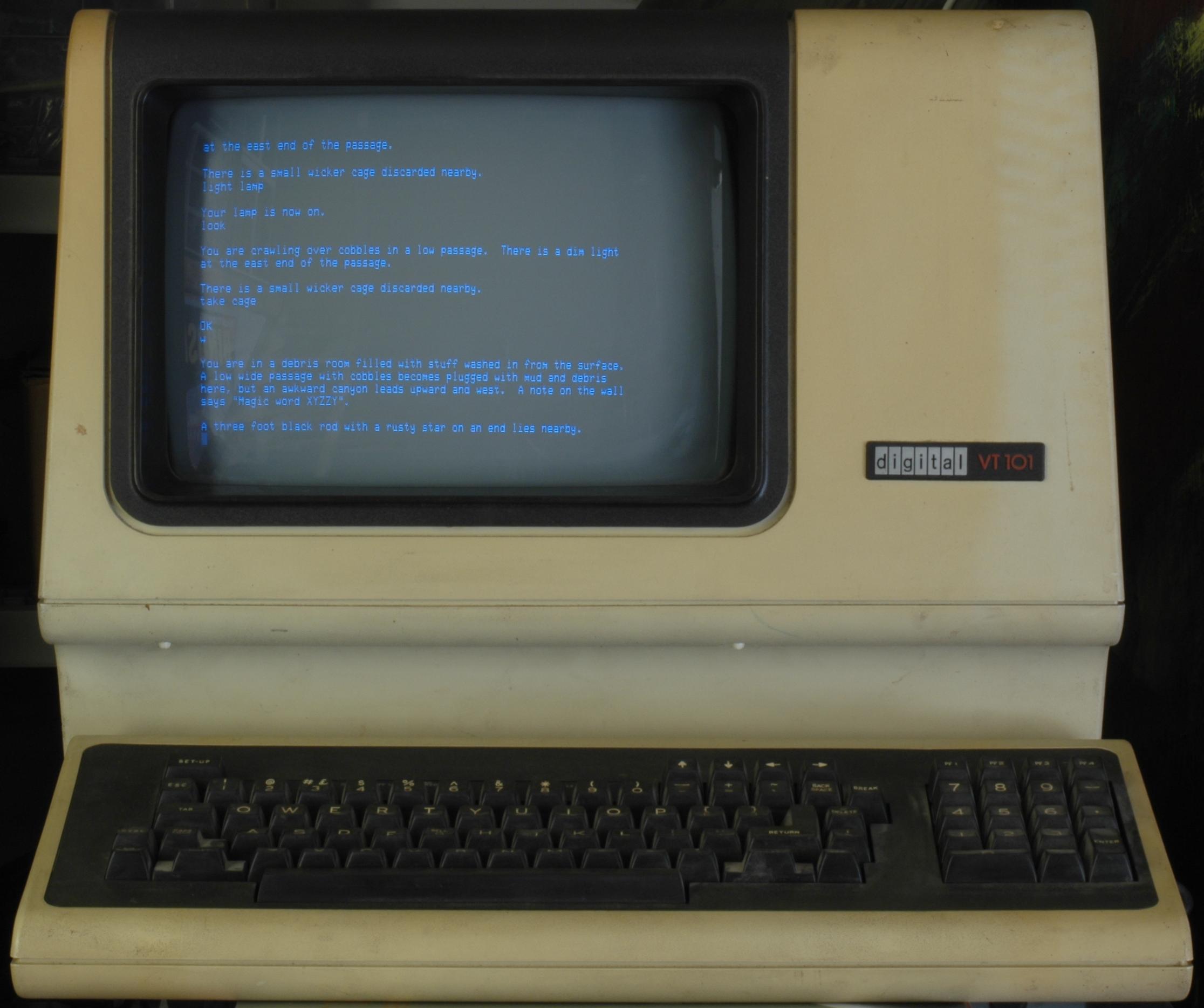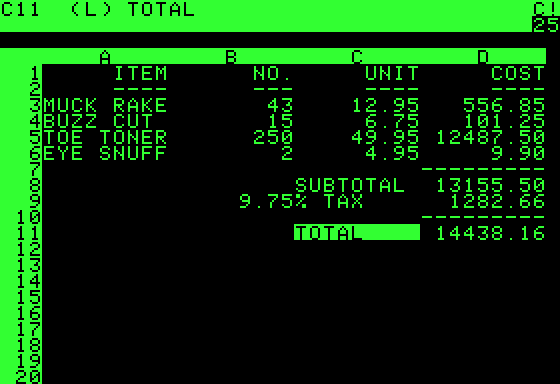|
VT-100
The VT100 is a video terminal, introduced in August 1978 by Digital Equipment Corporation (DEC). It was one of the first terminals to support ANSI escape codes for cursor control and other tasks, and added a number of extended codes for special features like controlling the status lights on the keyboard. This led to rapid uptake of the ANSI standard, which became the de facto standard for hardware video terminals and later terminal emulators. The VT100 series, especially the VT102, was extremely successful in the market, and made DEC the leading terminal vendor at the time. The VT100 series was replaced by the VT200 series starting in 1983, which proved equally successful. Ultimately, over six million terminals in the VT series were sold, based largely on the success of the VT100. Description DEC's first video terminal was the VT05 (1970), succeeded by the VT50 (1974), and soon upgraded to the VT52 (1975). The VT52 featured a text display with 80 columns and 24 rows, bidirection ... [...More Info...] [...Related Items...] OR: [Wikipedia] [Google] [Baidu] |
Digital Equipment Corporation
Digital Equipment Corporation (DEC ), using the trademark Digital, was a major American company in the computer industry from the 1960s to the 1990s. The company was co-founded by Ken Olsen and Harlan Anderson in 1957. Olsen was president until he was forced to resign in 1992, after the company had gone into precipitous decline. The company produced many different product lines over its history. It is best known for the work in the minicomputer market starting in the early 1960s. The company produced a series of machines known as the Programmed Data Processor, PDP line, with the PDP-8 and PDP-11 being among the most successful minis in history. Their success was only surpassed by another DEC product, the late-1970s VAX "supermini" systems that were designed to replace the PDP-11. Although a number of competitors had successfully competed with Digital through the 1970s, the VAX cemented the company's place as a leading vendor in the computer space. As microcomputers improved in t ... [...More Info...] [...Related Items...] OR: [Wikipedia] [Google] [Baidu] |
ADM-3
The ADM-3A is an early influential video display terminal, introduced in 1976. It was manufactured by Lear Siegler and has a 12-inch screen displaying 12 or 24 lines of 80 characters. It set a new industry low single unit price of $995. Its "dumb terminal" nickname came from some of the original trade publication advertisements. It quickly became commercially successful because of the rapid increase of computer communications speeds, and because of new minicomputer and microcomputer systems released to the market which required inexpensive operator consoles. History Lear Siegler, Inc. (LSI) manufactured its first video display terminal in 1972 – the 7700A. In 1973, LSI hired a new head of engineering, Jim Placak. He and his team created the ADM-1 later that year. It set a new pricing low in the industry at $1,500. Its lower cost was primarily due to a unique single printed circuit board design. In early 1973 the LSI division in Anaheim, California that manufactured the ... [...More Info...] [...Related Items...] OR: [Wikipedia] [Google] [Baidu] |
VT 131
Vermont Route 131 (VT 131) is a state highway in Windsor County, Vermont, United States. It starts at Vermont Route 103, VT 103 in Cavendish, Vermont, Cavendish and terminates at a junction with U.S. Route 5 (Vermont), U.S. Route 5 (US 5) and Vermont Route 12, VT 12 in the town of Weathersfield, Vermont, Weathersfield. Route description VT 131 begins at an intersection with Vermont Route 103, VT 103 in the Windsor County, Vermont, Windsor County town of Cavendish, Vermont, Cavendish on the shores of the Black River (Connecticut River), Black River. VT 131 runs southeast from VT 103 along Main Street in Cavendish, paralleling local railroad tracks as the main west–east road through the community. The route bends northeast in the village, passing a long string of residences, turning east at Twentymile Stream Road. Now paralleling the Black River, the route continues east through Cavendish, reaching the commercial center at a ju ... [...More Info...] [...Related Items...] OR: [Wikipedia] [Google] [Baidu] |
Non-volatile Memory
Non-volatile memory (NVM) or non-volatile storage is a type of computer memory that can retain stored information even after power is removed. In contrast, volatile memory needs constant power in order to retain data. Non-volatile memory typically refers to storage in memory chips, which store data in floating-gate memory cells consisting of floating-gate MOSFETs ( metal–oxide–semiconductor field-effect transistors), including flash memory storage such as NAND flash and solid-state drives (SSD). Other examples of non-volatile memory include read-only memory (ROM), EPROM (erasable programmable ROM) and EEPROM (electrically erasable programmable ROM), ferroelectric RAM, most types of computer data storage devices (e.g. disk storage, hard disk drives, optical discs, floppy disks, and magnetic tape), and early computer storage methods such as punched tape and cards. Overview Non-volatile memory is typically used for the task of secondary storage or long-term per ... [...More Info...] [...Related Items...] OR: [Wikipedia] [Google] [Baidu] |
Box-drawing Characters
Box-drawing characters, also known as line-drawing characters, are a form of semigraphics widely used in text user interfaces to draw various geometric frames and boxes. These characters are characterized by being designed to be connected horizontally and/or vertically with adjacent characters, which requires proper alignment. Box-drawing characters therefore typically only work well with monospaced fonts. In graphical user interfaces, these characters are much less useful as it is simpler to draw lines and rectangles directly with graphical APIs. However, they are still useful for command-line interfaces and plaintext Comment (computer programming), comments within source code. Some recent embedded systems also use proprietary character sets, usually extensions to ISO 8859 character sets, which include box-drawing characters or other special symbols. Other types of box-drawing characters are block elements, shade characters, and terminal graphic characters; these can be used ... [...More Info...] [...Related Items...] OR: [Wikipedia] [Google] [Baidu] |
Reverse Video
Reverse video (or invert video or inverse video or reverse screen) is a computer display technique whereby the background and text color values are inverted. On older computers, displays were usually designed to display text on a black background by default. For emphasis, the color scheme was swapped to bright background with dark text. Nowadays the two tend to be switched, since most computers today default to white as a background color. The opposite of reverse video is known as ''true video''. Video is usually reversed by inverting the brightness values of the pixels of the involved region of the display. If there are 256 levels of brightness, encoded as 0 to 255, the 255 value becomes 0 and vice versa. A value of 1 becomes 254, 2 of 253, and so on: ''n'' is swapped for ''r'' - ''n'', for ''r'' levels of brightness. This is occasionally called a ones' complement. If the source image is of middle brightness, reverse video can be difficult to see, 127 becomes 128 for example, w ... [...More Info...] [...Related Items...] OR: [Wikipedia] [Google] [Baidu] |
Backwards Compatibility
In telecommunications and computing, backward compatibility (or backwards compatibility) is a property of an operating system, software, real-world product, or technology that allows for interoperability with an older legacy system, or with Input/output, input designed for such a system. Modifying a system in a way that does not allow backward compatibility is sometimes called "wikt:breaking change, breaking" backward compatibility. Such breaking usually incurs various types of costs, such as Switching barriers, switching cost. A complementary concept is ''forward compatibility''; a design that is forward-compatible usually has a Technology roadmap, roadmap for compatibility with future standards and products. Usage In hardware A simple example of both backward and forward compatibility is the introduction of FM broadcasting, FM radio in stereophonic sound, stereo. FM radio was initially monaural, mono, with only one audio channel represented by one signal (electrical engineerin ... [...More Info...] [...Related Items...] OR: [Wikipedia] [Google] [Baidu] |
Computer Memory
Computer memory stores information, such as data and programs, for immediate use in the computer. The term ''memory'' is often synonymous with the terms ''RAM,'' ''main memory,'' or ''primary storage.'' Archaic synonyms for main memory include ''core'' (for magnetic core memory) and ''store''. Main memory operates at a high speed compared to mass storage which is slower but less expensive per bit and higher in capacity. Besides storing opened programs and data being actively processed, computer memory serves as a Page cache, mass storage cache and write buffer to improve both reading and writing performance. Operating systems borrow RAM capacity for caching so long as it is not needed by running software. If needed, contents of the computer memory can be transferred to storage; a common way of doing this is through a memory management technique called ''virtual memory''. Modern computer memory is implemented as semiconductor memory, where data is stored within memory cell (com ... [...More Info...] [...Related Items...] OR: [Wikipedia] [Google] [Baidu] |
Microprocessor
A microprocessor is a computer processor (computing), processor for which the data processing logic and control is included on a single integrated circuit (IC), or a small number of ICs. The microprocessor contains the arithmetic, logic, and control circuitry required to perform the functions of a computer's central processing unit (CPU). The IC is capable of interpreting and executing program instructions and performing arithmetic operations. The microprocessor is a multipurpose, Clock signal, clock-driven, Processor register, register-based, digital integrated circuit that accepts binary code, binary data as input, processes it according to instruction (computing), instructions stored in its computer memory, memory, and provides results (also in binary form) as output. Microprocessors contain both combinational logic and sequential logic, sequential digital logic, and operate on numbers and symbols represented in the binary number system. The integration of a whole CPU on ... [...More Info...] [...Related Items...] OR: [Wikipedia] [Google] [Baidu] |





